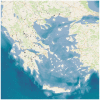Isolation of Biofilm-Forming Staphylococci from the Bulk-Tank Milk of Small Ruminant Farms in Greece
- PMID: 37569105
- PMCID: PMC10417191
- DOI: 10.3390/foods12152836
Isolation of Biofilm-Forming Staphylococci from the Bulk-Tank Milk of Small Ruminant Farms in Greece
Abstract
The objectives of this study were (i) to describe staphylococcal isolates recovered from bulk-tank raw milk collected from sheep and goat farms during a countrywide study performed in Greece, (ii) to study management factors potentially associated with their presence in bulk-tank milk and (iii) to provide evidence regarding their association with the quality of the milk. In total, 312 staphylococcal isolates, recovered from samples of bulk-tank raw milk from 444 small ruminant farms in Greece, were evaluated in this work. The in vitro formation of biofilm by the isolates was tested by combining the findings of (a) culture appearance on Congo Red agar plates and (b) results of a microplate adhesion test. The most frequently identified species was Staphylococcus aureus (75 isolates); other frequently recovered species were S. simulans (44 isolates), S. equorum (34 isolates) and S. haemolyticus (26 isolates); in total, 23 species were identified. In total, 224 (71.8%) isolates were biofilm-forming and were recovered from the bulk-tank milk samples of 148 sheep flocks (45.5%) and 55 goat herds (46.2%). There was evidence of seasonality in the isolation of staphylococci: during spring, mostly biofilm-forming isolates were recovered, whilst during summer, mostly non-biofilm-forming isolates were recovered. Among farms applying machine-milking, the proportion of farms from which biofilm-forming isolates were recovered was higher where water with temperature < 50 °C or ≥90 °C was used to clean the milking parlour. In the multivariable analyses, for farms applying machine-milking, the temperature of the water emerged as the only significant variable (p = 0.024), whilst in farms applying hand-milking, the only tendency that emerged was for the frequency of collection of milk from the farm tank (p = 0.08). In sheep flocks, recovery of biofilm-forming staphylococci from the bulk-tank milk was associated with higher somatic cell counts and higher total bacterial counts in the milk. The study identified abiotic factors related to the presence and isolation of these bacteria, specifically the temperature of water used for the cleaning of the milking parlour (in farms where machine-milking is applied) and the frequency of milk collection from the farm tank. These factors apply after the production of milk, and they could thus be regulated appropriately in order to reduce bacterial load and improve the quality of milk delivered to dairy plants. In sheep farms, an association was also seen between recovery of biofilm-forming staphylococci and high somatic cell counts in milk.
Keywords: Staphylococcus; biofilm; goat; mastitis; milk; sheep; slime; somatic cell counts.
Conflict of interest statement
The authors declare no conflict of interest.
Figures





References
-
- Perez M.M., Prenafeta A., Valle J., Penades J., Rota C., Solano C., Marco J., Grillo M.J., Lasa I., Irache J.M., et al. Protection from Staphylococcus aureus mastitis associated with poly-N-acetyl beta-1,6 glucosamine specific antibody production using biofilm-embedded bacteria. Vaccine. 2009;27:2379–2386. doi: 10.1016/j.vaccine.2009.02.005. - DOI - PMC - PubMed
-
- Michael C.K., Lianou C.K., Vasileiou N.G.C., Tsilipounidaki K., Katsafadou A.I., Politis A.P., Kordalis N.G., Ioannidi K.S., Gougoulis D.A., Trikalinou C., et al. Association of staphylococcal populations on teatcups of milking parlours with vaccination against staphylococcal mastitis in sheep and goat farms. Pathogens. 2021;10:385. doi: 10.3390/pathogens10040385. - DOI - PMC - PubMed
LinkOut - more resources
Full Text Sources

